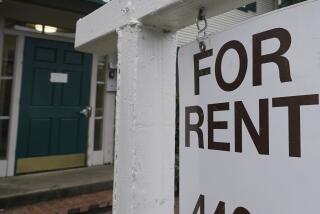Landlord needs a reason to step on in
- Share via
Can landlords just waltz in unannounced because they own the place? Yes and no.
In case of emergency or court order, yes, the owner has the right. For handling routine repairs, however, 24 hours’ notice must be given. Other notice situations for entry include showing the rental to prospective new tenants or buyers of the property.
So what’s an emergency? Any sudden or unexpected occurrence that could cause harm or damage. Fire, water or strong smells often indicate trouble.
Sudden water leaks, for example, cannot wait. Say a panicked renter finds a large puddle of water on his way to the fridge for a midnight snack. Waiting is not an option if the landlord needs to get into an upstairs unit to investigate the cause and that tenant is out of town.
But leaving a note or calling to say the premises were entered is always a good idea for both parties. No one likes his or her privacy invaded without explanation.
Defining nonemergency repairs is pretty straightforward too. Section 1954 of California civil law specifies the right of a landlord or repair person to come into a tenant’s home “to make necessary or agreed upon repairs, decorations, alterations or improvements, supply necessary or agreed services.”
When something needs fixing, the owner or agent has the right to come in and repair the item during normal business hours. While business hours are not defined by code, they typically are considered 9 a.m. to 5 p.m. on weekdays and 10 a.m. to 1 p.m. on Saturdays. Twenty-four hours is considered reasonable notice for entry.
Sometimes repairs require multiple visits. For a paint touch-up request, for example, a visit to the unit may be needed first, simply to determine the color. Not every landlord keeps track of the color on each particular wall, and there are dozens of shades of white. A second or third visit may be required to patch and finish the job. Patience and flexibility are required by both sides.
The landlord should give a range of expected entry dates for maintenance and send a note or call about any further visits required. Written notice is expected if the landlord is making an entry for nonemergency purposes, with 24 hours being the standard lead time.
For the tenant’s part, communicating the repair problem clearly may save extra visits. Leaving messages that say “The plumbing is dripping” will generate more visits and aggravation than “The hall bathroom sink faucet is dripping hot water.” The more information the tenant provides, the more likely that the repair person can bring the correct part to fix the problem.
Giving notice to move also opens the door to landlord entry. After all, the place can only be re-rented if prospective tenants see it. With cell phones and pagers, many applicants call the landlord and want to see a rental “right away.” Work out a mutual block of time with your landlord when it is convenient for showing your unit, and try to keep the place in showable condition. The sooner the dwelling is rented, the sooner the showings will cease.
While landlords should not abuse their right of access, tenants should be fair in allowing access for most situations.
Abandonment and court order are the final situations in which a landlord may enter a rental. Once the law has stepped in to remove a tenant, the right to the dwelling falls back to the owner; any abandoned items may be sold after a specific period of time and according to requirements outlined in Code 1951.3. Details are available at www.leginfo.ca.gov and are found under the “hiring” portion of the Civil Code.
*
Reader comments may be sent to hmayspitz@aol.com. No attachments please.
More to Read
Sign up for Essential California
The most important California stories and recommendations in your inbox every morning.
You may occasionally receive promotional content from the Los Angeles Times.






